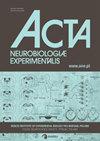Effect of levetiracetam on DNA oxidation and glutathione content in a temporal lobe epilepsy model
IF 1.4
4区 医学
Q4 NEUROSCIENCES
引用次数: 0
Abstract
Levetiracetam (LEV) is a drug commonly used as an anticonvulsant. However, recent evidence points to a possible role as an antioxidant. We previously demonstrated the antioxidant properties of LEV by significantly increasing catalase and superoxide dismutase activities and decreasing the hydrogen peroxide (H2O2) levels in the hippocampus of rats with temporal lobe epilepsy (TLE) showing scavenging properties against the hydroxyl radical. The aim of the present work was to evaluate, the effect of LEV on DNA oxidation, by determining 8‑hydroxy‑2‑deoxyguanosine (8‑OHdG) levels, and glutathione content, through reduced (GSH) and oxidized (GSSG) glutathione levels, in the hippocampus of rats with TLE. Male Wistar rats were assigned to the control (CTRL), CTRL+LEV, epileptic (EPI) and EPI+LEV groups. TLE was induced using the lithium‑pilocarpine model. Thirteen weeks after TLE induction, LEV was administered for one week through osmotic pumps implanted subcutaneously. The determination of 8‑OHdG, GSH and GSSG levels were measured using spectrophotometric methods. We showed that LEV alone significantly increased 8‑OHdG and GSSG levels in the hippocampus of control rats compared to those in epileptic condition. No significant differences in GSH levels were observed. LEV could induce changes in the hippocampus increasing DNA oxidation and GSSG levels under nonepileptic condition but not protecting against the mitochondrial dysfunction observed in TLE probably by mechanisms related to changes in chromatin structure, neuroinflammation and alterations in redox components.左乙拉西坦对颞叶癫痫模型中 DNA 氧化和谷胱甘肽含量的影响
左乙拉西坦(LEV)是一种常用的抗惊厥药物。不过,最近有证据表明它可能具有抗氧化作用。我们曾证明左乙拉西坦具有抗氧化特性,它能显著提高颞叶癫痫(TLE)大鼠海马中过氧化氢(H2O2)的清除能力,并能提高过氧化氢酶和超氧化物歧化酶的活性,降低过氧化氢(H2O2)的水平。本研究的目的是通过测定颞叶癫痫大鼠海马中的 8-羟基-2-脱氧鸟苷(8-OHdG)水平和谷胱甘肽含量(通过还原型谷胱甘肽(GSH)和氧化型谷胱甘肽(GSSG)水平),评估 LEV 对 DNA 氧化的影响。雄性 Wistar 大鼠被分为对照组(CTRL)、CTRL+LEV 组、癫痫组(EPI)和 EPI+LEV 组。采用锂-匹罗卡品模型诱导TLE。TLE诱导13周后,通过皮下注射渗透泵给LEV一周。采用分光光度法测定 8-OHdG、GSH 和 GSSG 水平。结果表明,与癫痫状态下的大鼠相比,单独使用 LEV 能显著增加对照组大鼠海马中的 8-OHdG 和 GSSG 水平。而 GSH 水平则无明显差异。在非癫痫状态下,LEV可诱导海马发生变化,增加DNA氧化和GSSG水平,但不能防止在TLE中观察到的线粒体功能障碍,其机制可能与染色质结构变化、神经炎症和氧化还原成分的改变有关。
本文章由计算机程序翻译,如有差异,请以英文原文为准。
求助全文
约1分钟内获得全文
求助全文
来源期刊
CiteScore
2.20
自引率
7.10%
发文量
40
审稿时长
>12 weeks
期刊介绍:
Acta Neurobiologiae Experimentalis (ISSN: 0065-1400 (print), eISSN: 1689-0035) covers all aspects of neuroscience, from molecular and cellular neurobiology of the nervous system, through cellular and systems electrophysiology, brain imaging, functional and comparative neuroanatomy, development and evolution of the nervous system, behavior and neuropsychology to brain aging and pathology, including neuroinformatics and modeling.

 求助内容:
求助内容: 应助结果提醒方式:
应助结果提醒方式:


